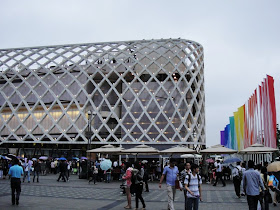 Below is my second posting from Shanghai that was kindly published in the Vancouver Sun:
Below is my second posting from Shanghai that was kindly published in the Vancouver Sun:Why can't buildings wear coats to keep the heat in and the cold out?
This is one of the questions asked at the U.K. pavilion at Shanghai Expo 2010. The answer? They can wear coats. In fact, a layer of vegetation incorporated into a green roof can help control the temperature of a building while improving energy efficiency.
At the nearby France pavilion, an even more dramatic solution is being proposed.
Lafarge Cement, which developed an innovative lightweight material for the exterior of the pavilion, is proposing full-length decorative concrete "coats" for older highrise buildings. These would support vegetation and other energy-saving devices to improve comfort and energy efficiency. The visual result is not unlike the futuristic visions of cities illustrated in 1950s comic books and magazines.


However, after spending a week touring this world fair, I find these visions not so improbable. Indeed, many of the pavilions incorporate stunning futuristic exterior designs.
Often, they are a riot of colour, composed from crystal resin and vibrant LED screens. An "intelligent film" on the Private Enterprises Pavilion produces different visual effects as viewing and sunlight angles change. Advanced digital projection technologies allow facades to be constantly changing, especially at night when the Expo grounds turn into a digital fireworks extravaganza.
Watching some of these buildings, I could not help but think about the public furore in Vancouver over the installation of a small electronic billboard at the south end of the Burrard Bridge.
The interior displays are often equally fantastic. A video projection in the Canada Pavilion gives the impression that the screen is changing its form, and indeed it might be.
As you enter the EcoHouse, you walk over a digital pond with koi swimming below. Many people gingerly dip their toe into the "water" before venturing across. In the Spain Pavilion, a flamenco dancer suddenly appears out of a giant projection. And then there is Meguelin, the 6.5-metre animated baby, which has to be seen to be believed.
Every pavilion displays ideas to create more sustainable buildings and cities. The Germany Pavilion illustrates how older mid-20th-century public housing blocks can be transformed into "urban villas" through energy refurbishment measures and the addition of balconies. Many older Vancouver projects could benefit from a similar approach.
Other German innovations include a system of car-sharing in Bremen that allows users to drop off cars wherever they want; intergenerational and intercultural community allotment gardens in Stuttgart that bring together different ethnicities and age groups; and a "Tree Godparent" program for people wanting to do something for the environment, but not wanting the full responsibility of maintaining a community garden.
The Pavilion of the Future presents Columbia University's Dragonfly Project, which is developing artificial trees that will capture carbon dioxide 1,000 times faster than real trees. Another display explores the possibilities of permanent floating communities on international waters.
Closer to home, and present-day realities, the EcoHouse features a kitchen with an intelligent refrigerator and "nutrition butler" who tells you the composition of the foods you are eating. The bathroom includes an intelligent toilet that analyzes urine and stools to let you know when it is time to see a doctor or revise your will.
 The pavilions make it apparent that many cities are creatively greening themselves.
The pavilions make it apparent that many cities are creatively greening themselves.
If Vancouver wants to be the greenest city in the world, (ed: as the Mayor says in the Vancouver Pavilion) we should pay close attention to what others are doing. There is some stiff competition out there.
 Michael Geller is a Vancouver-based architect, planner, real estate consultant and property developer.
Michael Geller is a Vancouver-based architect, planner, real estate consultant and property developer.
No comments:
Post a Comment